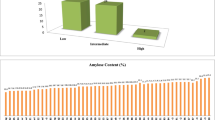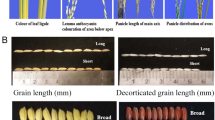Abstract
A protocol for jasmine rice authentication was established in order to determine whether a Thai jasmine rice product meets legal requirement. Both RAPD and SCAR methods were used on the basis of previous study of jasmine-rice specific genome characteristics. Two RAPD markers, RI2-449 and RI5-1107, were selected and SCAR primer pairs were designed for RI5-1107. Twenty-four rice cultivars, which represented typical jasmine rice and non-jasmine rice were analyzed to confirm the specificity and reproducibility of DNA method. The purity of jasmine rice was calculated by analyzing every single kernel from test sample. Five in-house prepared samples were quantified to prove the accuracy of DNA method, and 15 imported samples were analyzed by DNA method as well as physical/chemical method to confirm the consistency between DNA method and traditional method. Based on the standard deviation obtained by comparing DNA method and traditional method, a testing threshold for jasmine rice was decided. Investigation of eight commercial samples from market showed that 75% products meet the requirement.







Similar content being viewed by others
References
Dennis MJ (1998) Analyst 123:151R–156R
Maller M (2003) http://www.engagetheworld.org/Rice%20Research/JasmineRice.
Cheaupun K, Wongpiyachon S, Kongseree N (2003) http://www.irri.org/publications/wrrc/wrrcPDF/session8-02.pdf.
Paran I, Michelmore RW (1993) Theor Appl Genet 85:985–993
Cruz ND, Khush GS (2001) Aromatic rice. Oxford and IBH Publishing Co. Pvt. Ltd, New Delhi, pp 56–82
Jin QS, Vanavichit S (1996) J Genet Breed 50(36):7–370
Koller B, Lehmann A, Mcdermott JM, Gessler C (1993) Theor Appl Genet 85:901–904
Wu YJ, Chen Y, Wang J, Zhu CX, Xu BL (2006) Genome 6(46):716–719
Lally D, Ingmire P, Tong H-Y, He Z-H (2001) Plant cell 13:1317–1331
Emslie KR, Whaites L, Griffiths KR, Murby EJ (2007) J Agric Food Chem 55:4414–4421
Acknowledgments
This study was funded by the project of “Detection system and technological research of product of specified geographical origin” of Ministry of Science and Technology, People’s Republic of China (10-85-3) and General Administration of Quality Supervision, Inspection and Quarantine (AQSIQ), People’s Republic of China (2005IK013).
Author information
Authors and Affiliations
Corresponding author
Rights and permissions
About this article
Cite this article
Wu, Y., Zhang, Z., Chen, Y. et al. Authentication of Thailand jasmine rice using RAPD and SCAR methods. Eur Food Res Technol 229, 515–521 (2009). https://doi.org/10.1007/s00217-009-1072-6
Received:
Revised:
Accepted:
Published:
Issue Date:
DOI: https://doi.org/10.1007/s00217-009-1072-6




